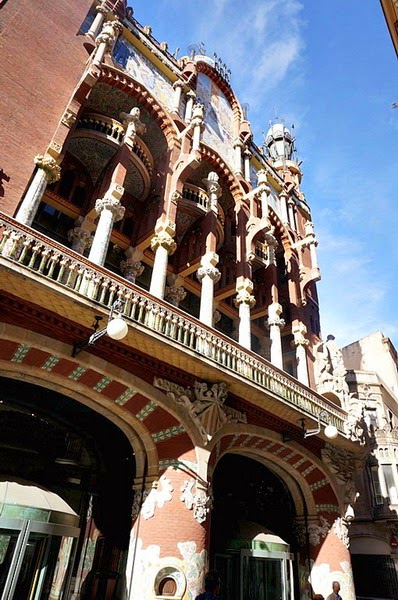食完我哋就去睇呢個加泰羅尼亞音樂廳 (Palau de la Música Catalana ),呢個音樂廳係條橫街到,佢個外型又係好特別,如果大家對音樂廳又興趣,佢係有D Tour 可以俾參觀人士Join嘅,不過我哋就無興趣喇。不過係網上面睇個有人Join咗入去參觀,個表演廳都幾靚。
加泰羅尼亞音樂宮(Palau de la Música Catalana)是西班牙巴塞隆納的一座音樂廳,興建於1905年到1908年,現代主義風格,設計者是建築師路易·多梅內克·蒙塔內爾。業主是1891年創辦的加泰羅尼亞合唱團(Orfeó Català),加泰羅尼亞文化運動的領導力量,被稱為加泰羅尼亞重生(Renaixença)[1]。1908年2月9日開幕。
1997年,加泰羅尼亞音樂宮和聖十字和聖保羅醫院一起被聯合國教科文組織宣布為世界遺產。今天,每年有超過50萬人出席在加泰羅尼亞音樂宮的各種音樂表演,從從交響樂及室內樂,到爵士樂和坎索(加泰羅尼亞語歌曲)。
加泰羅尼亞音樂宮坐落在狹窄的街道,立面裝飾豐富,而且結合了多種元素,包括傳統的西班牙元素和阿拉伯元素。
之後我哋就去睇下呢個Mercat de Santa Caterina 市場,呢個市場重建之後就整咗個五彩玻璃頂,要睇到呢個玻璃頂我諗要係附近嘅高處先睇到。我哋都係係門口同埋入面影相,入面都係同一般市場差不多,又嘢買又有嘢食~~~
Mercat de Santa Caterina[edit]
Located in La Ribera just off the Via Laietana, the Mercat de Santa Caterina was recently remodeled with a colorful undulating roof. During the remodeling, the market was relocated to the stretch of the Passeig de Sant Joan in between the Arc de Triomf and the city's Parc de la Ciutadella. It has been in operation since 1848.[3] It serves an area also previously served by the Mercat del Born, which has been converted into an archaeological site preserving the foundations of the older neighborhood underneath its roof.
睇完呢個我哋又去睇另外一個市場Mercat del Born 舊倫布市場,行行見到有一間租小型電車嘅舖頭,不租一架呢D車都唔平,要成EUR$70租三個鐘~~呢架電車仔好似無記個個三個小生去旅遊都有租來玩~~




去到呢個Mercat del Born 舊倫布市場出面例牌影下相啦,開頭我哋重以為呢個都係一個市場添,但係呢個市場就好大面積。點知入到去,原來係一個遺跡來嘅,入面重有間餐廳係到添~~原先呢到真係一個市場來嘅,不過係2002年個時重建個時進行挖掘工程時,意外地發現咗一個遺跡係個市場地下,所以家下就變成咗一個景點,其實佢都係今年9月先開放俾公眾參觀架咋~~
Mercat del Born is one of the most important buildings in Barcelona, Catalonia, Spain constructed with iron. Located in the lower, east side of the la Ribera neighborhood, it is the largest covered square in all of Europe and marked the start of Modernisme in Catalan architecture.[1]
Design[edit]
The market is rectangular, with two large domed, intersecting buildings, and 4 smaller naves. The structure is supported on cast iron columns with a flat roof covered in glazed tile.[2]
History[edit]
It was designed in 1873 by the municipal architect Antoni Rovira i Trias (who also designed the Mercat de Sant Antoni) and built between 1874 and 1878 by master builder Joseph Fontserè, and engineer Joseph Cornet i Mas.[2] The structure of cast iron columns and metallic horses was fabricated by La Maquinista Terrestre i Marítima.
The market came into operation in 1878 and was in use as the central market in town until 1971. At its closure, it was functioning as a wholesale market, but was replaced with the opening of Mercabarna in Zona Franca.[3]
Born "District"[edit]
In recent years, the area immediately surrounding the market has been referred to as "el Born" or the incorrect, spanified variant, "el Borne". A heavily gentrified area considered to be south of Carrer de la Princesa, it is full of restaurants, bar, and some small shops with many expatriates both living and socializing there. Despite this colloquial name given to the area (which is often applied to the entire district), it is still officially called la Ribera or Sant Pere, Santa Caterina i la Ribera.[1]
Restoration[edit]
Restoration work started and stopped several times since the closure of market. Each successive city government had a different plan for the very large space. At some points, there were even plans to lease it to a retail establishment such as FNAC who had expressed interest.[1]
After closure, it fell into a state of disrepair and was restored 1977 to 1981 under the direction of Pere Espinosa.[2]
In 2002 work was started to install the Biblioteca Provincial de Barcelona, but during excavations, extensive ruins of the medieval city were discovered.[2] It was then decided to preserve the ruins and move the library project to another location.[3]
Currently, the market covers these archaeological ruins which were part of the la Ribera district that was demolished in the early eighteenth century after the defeat of Catalonia in the War of Succession in 1714. This portion of la Ribera was forcibly demolished to make way for the construction of the Ciutadella military structure as ordered by the new Spanish king, Philip V.[2]
The plan that finally came to fruition in 2013 was to expose the subterranean ruins for visitors while preserving space around the exterior of them for mixed use, cultural center, in addition to having a museum about the War of Succession onsite. At the same time, it is now possible for pedestrians to pass freely from Passeig del Born through to the other side that leads to the park of Ciutadella.[1]
The official inauguration of the restored market was September 11, 2013 which was the 299th anniversary of the fall of Barcelona following its siege that marked the end of an independent Catalonia state and the start of nearly three centuries of suppression of Catalan autonomy by the Spanish Kingdom.[4]













































It is quite special for a market to be transformed into a remains site during reconstruction.
回覆刪除外國對於保護歷史嘢都真係做得幾好
刪除